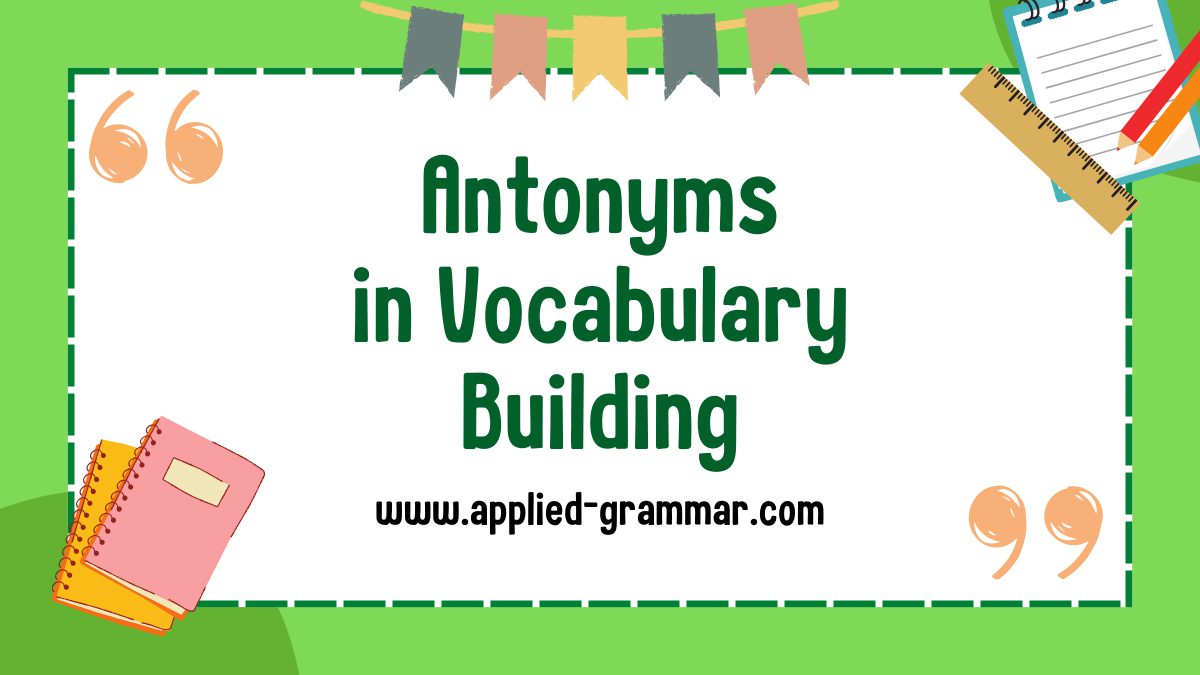Are you looking to enhance your vocabulary and expand your word knowledge? Well, look no further because antonyms are here to help you! Antonyms, or words with opposite meanings, play a crucial role in vocabulary building. By familiarizing yourself with antonyms, you not only gain a deeper understanding of words, but you also improve your ability to express yourself effectively.
In various exams, including the tenth standard exam, questions based on vocabulary are quite common. Synonyms and antonyms are frequently tested, making it essential to have a strong grasp of both. While synonyms help you express yourself more precisely, antonyms allow you to comprehend different concepts more effectively. Also, mastering antonyms can greatly enhance your overall vocabulary skills.
Key Takeaways
- Antonyms, or words with opposite meanings, are crucial for vocabulary building and expanding word knowledge.
- Familiarizing yourself with antonyms helps you gain a deeper understanding of words and improves your ability to express yourself effectively.
- Antonyms can be classified into different types, including gradable, complementary, relational, and converse antonyms.
- Mastering antonyms enhances word comprehension, improves language precision, enhances critical thinking, and helps in exam preparation.
- Strategies for expanding word knowledge include reading widely, using contextual clues, utilizing a thesaurus, and learning word families.
- Practice exercises for antonyms, such as fill in the blanks, matching antonyms, and creating antonym pairs, are effective for reinforcing understanding and improving vocabulary skills.
- Antonyms can be used in writing to enhance vocabulary in descriptive writing, create contrast in argumentative writing, and evoke emotional impact.
- By incorporating antonyms into writing, you can improve your writing skills, create more impactful content, and engage the reader on a deeper level.
Understanding Antonyms
In your journey to expand your vocabulary and word knowledge, it’s important to understand the role of antonyms. Antonyms are words with opposite meanings, and they play a crucial role in vocabulary building and enhancing your ability to express yourself effectively. Let’s explore the definition of antonyms, the different types of antonyms, and the importance of incorporating them into your vocabulary-building efforts.

Definition of Antonyms
Antonyms are words that have opposite meanings. When you encounter an antonym, it is the polar opposite of the word you already know. For example, “hot” and “cold” are antonyms because they represent opposite temperature extremes. By familiarizing yourself with antonyms, you are able to grasp the nuances of language and effectively express contrasting ideas.
Types of Antonyms
Antonyms can be classified into different types based on the nature of their contrasting meanings. Here are some common types of antonyms:
- Gradable antonyms: These antonyms represent opposite ends of a spectrum and allow for various levels or degrees. For example, “hot” and “cold” are gradable antonyms as they represent different degrees of temperature.
- Complementary antonyms: These antonyms represent an either/or relationship and have no middle ground. For example, “alive” and “dead” are complementary antonyms because there is no state that exists between being alive and being dead.
- Relational antonyms: These antonyms are words that are opposites because of the relationship between them. For example, “buy” and “sell” are relational antonyms as they represent opposite actions in a transaction.
- Converse antonyms: These antonyms are words that describe the same relationship from different perspectives. For example, “borrow” and “lend” are converse antonyms as they represent different sides of a lending transaction.
Importance of Antonyms in Vocabulary Building
Mastering antonyms is crucial for vocabulary building and expanding your word knowledge. Here’s why:
- Enhances word comprehension: Understanding antonyms helps you grasp the full range of meanings associated with a word. By knowing the opposite of a given word, you gain a deeper understanding of its nuances and implications.
- Improves language precision: Antonyms enable you to express contrasting ideas or opinions more precisely. They allow you to communicate with accuracy and clarity, making your writing or speaking more effective.
- Enhances critical thinking: Working with antonyms encourages you to think critically and analyze the subtle differences in meaning. It helps you develop a more nuanced perspective and enables you to compare and contrast concepts more effectively.
- Helps in exam preparation: Antonym questions are commonly found in exams, especially in vocabulary-based sections. Having a strong grasp of antonyms can significantly improve your performance in such tests.
By incorporating antonyms into your vocabulary-building efforts, you’ll not only expand your word knowledge, but also develop your ability to express yourself with precision and clarity. So, make sure to discover the area of antonyms and embrace their power in enhancing your overall vocabulary skills.
Strategies for Expanding Word Knowledge

Reading Widely
One of the most effective strategies for expanding your word knowledge is reading widely. By exposing yourself to a diverse range of topics and writing styles through books, articles, and blogs, you can encounter new words, phrases, and idioms. Reading widely enables you to expand your vocabulary and learn how to use words in context. Explore different genres of literature and nonfiction to further diversify your reading experience and encounter a wider variety of vocabulary.
Contextual Clues
Utilizing contextual clues is another valuable strategy for expanding your word knowledge. Contextual analysis involves inferring the meaning of an unfamiliar word by examining the surrounding text. By paying close attention to the words and phrases used before and after the unfamiliar word, you can gather clues and make an educated guess about its meaning. This strategy allows you to expand your vocabulary by learning new words in their appropriate context.
Using a Thesaurus
The use of a thesaurus is an excellent tool for expanding your word knowledge. A thesaurus provides synonyms (words with similar meanings) and antonyms (words with opposite meanings) for a given word. By referring to a thesaurus, you can explore different words with similar or opposite meanings, enhancing your vocabulary and giving you more options for expressing yourself effectively. When using a thesaurus, be sure to choose words that accurately convey your intended meaning and fit the context of your writing or speech.
Learning Word Families
Another effective strategy for expanding your word knowledge is to learn word families. Word families consist of a base word and its various forms, such as prefixes and suffixes. By understanding the meaning and usage of these word parts, you can easily decipher the meanings of related words. For example, knowing that the prefix “un-” means “not” and the base word “happy” means “feeling pleasure,” you can quickly understand that “unhappy” means “not feeling pleasure.” Learning word families allows you to expand your vocabulary by recognizing patterns and making connections between words.
Incorporating these strategies into your vocabulary-building efforts will greatly enhance your word knowledge and improve your ability to express yourself effectively. By reading widely, using contextual clues, utilizing a thesaurus, and learning word families, you can continue to expand your vocabulary and develop your language skills.
Practice Exercises for Antonyms
Introducing practice exercises can be an effective way to reinforce your understanding of antonyms and expand your word knowledge. These exercises provide hands-on opportunities to actively engage with antonyms and improve your vocabulary skills. In this section, we will explore three types of practice exercises for antonyms: Fill in the Blanks, Matching Antonyms, and Creating Antonym Pairs.

Fill in the Blanks
In this exercise, you will be presented with a set of sentences or phrases with missing words. Your task is to fill in the blanks with the appropriate antonyms. This exercise not only helps you practice recognizing antonyms, but also reinforces your understanding of word meanings and context.
Example:
- The weather today is ________, unlike yesterday when it was sunny.
- a) cloudy b) clear c) windy d) hot
Matching Antonyms
Matching exercises are another effective way to practice antonyms. In this exercise, you will be given a list of words and their antonyms. Your goal is to match each word with its correct antonym. This exercise helps you develop your ability to recognize and identify antonyms, as well as reinforce your understanding of word relationships.
Example:
- Match the words with their antonyms:
- happy (a) sad
- big (b) small
- fast (c) slow
- good (d) bad
Creating Antonym Pairs
Creating antonym pairs is a more advanced exercise that challenges you to think critically and expand your word knowledge. In this exercise, you will be given a set of words, and your task is to come up with their antonyms. This exercise not only tests your knowledge of antonyms, but also encourages you to explore the nuances and opposite meanings of words.
- Create antonym pairs for the following words:
- love – ________
- up – ________
- happy – ________
- old – ________
By regularly practicing these exercises, you can strengthen your understanding of antonyms and expand your word knowledge. The more you engage with antonyms, the better equipped you will be to express yourself effectively and communicate with precision.
Using Antonyms in Writing
Antonyms play a crucial role in expanding your vocabulary and enhancing your word knowledge. By understanding and utilizing antonyms effectively, you can improve your writing skills and create more impactful and engaging content. In this section, we will explore how antonyms can be used in different genres of writing to enhance your expression, create contrast, and evoke emotional impact.

Enhancing Vocabulary in Descriptive Writing
In descriptive writing, antonyms can be used to add depth and richness to your descriptions. By incorporating antonyms that convey contrasting meanings, you can paint a vivid picture in the reader’s mind. For example, instead of describing a sunny day as simply “bright,” you can use the antonym “gloomy” to evoke a different mood and create a more nuanced description.
Plus to adding depth, antonyms can also help you choose the most precise words to describe your subject. By using antonyms, you can highlight specific characteristics or qualities. For instance, instead of saying something is “big,” you can use the antonym “small” to provide a clearer and more detailed description.
Creating Contrast in Argumentative Writing
Antonyms are particularly useful in argumentative writing, where the goal is to present opposing viewpoints and persuade the reader. By using antonyms, you can create a clear contrast between different arguments or ideas, making your writing more compelling.
When presenting counterarguments, antonyms can help you emphasize the differences between your stance and opposing viewpoints. By using antonyms, you can highlight the contradictions and counterpoints, making your argument stronger and more persuasive.
Using Antonyms for Emotional Impact
Emotions are an integral part of writing, and antonyms can be powerful tools for evoking specific emotions in the reader. By using antonyms that convey contrasting emotions, you can create a stronger emotional impact and engage the reader on a deeper level.
For example, in a narrative, using antonyms like “love” and “hate,” or “joy” and “sorrow,” can help to heighten the emotional tension and draw the reader into the story. Similarly, in persuasive writing, antonyms that evoke contrasting emotions can help you sway the reader’s opinion by appealing to their emotions.
Conclusion
Expanding your word knowledge and enhancing your vocabulary is crucial for effective communication and success in exams. Antonyms play a vital role in this process, allowing you to express yourself with precision and clarity. By understanding antonyms, you can add depth and richness to your writing, create clear contrasts between arguments, and evoke emotional impact in your readers.
To expand your word knowledge, it is important to read widely and expose yourself to a variety of texts. Utilizing contextual clues can help you understand the meaning of unfamiliar words and their antonyms. Also, using a thesaurus and learning word families can further broaden your vocabulary.
Practice exercises, such as fill in the blanks, matching antonyms, and creating antonym pairs, are effective tools for reinforcing your understanding of antonyms and improving your vocabulary skills. These exercises will enhance your ability to recognize and identify antonyms in different contexts.
To conclude, incorporating antonyms into your writing and speech will not only enhance your expression but also make your communication more engaging and persuasive. By mastering antonyms, you will have a powerful tool at your disposal to expand your word knowledge and improve your overall language skills.
